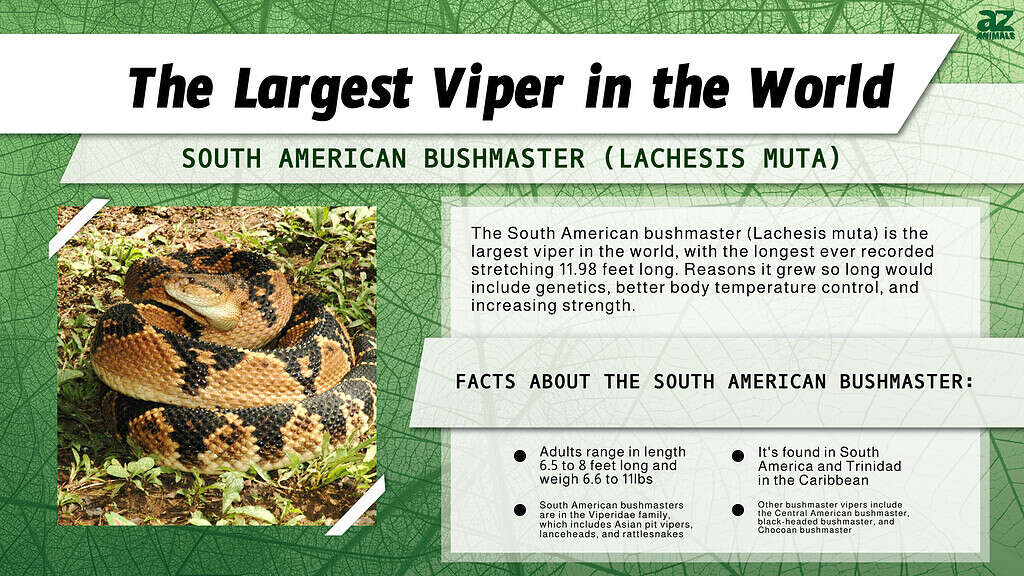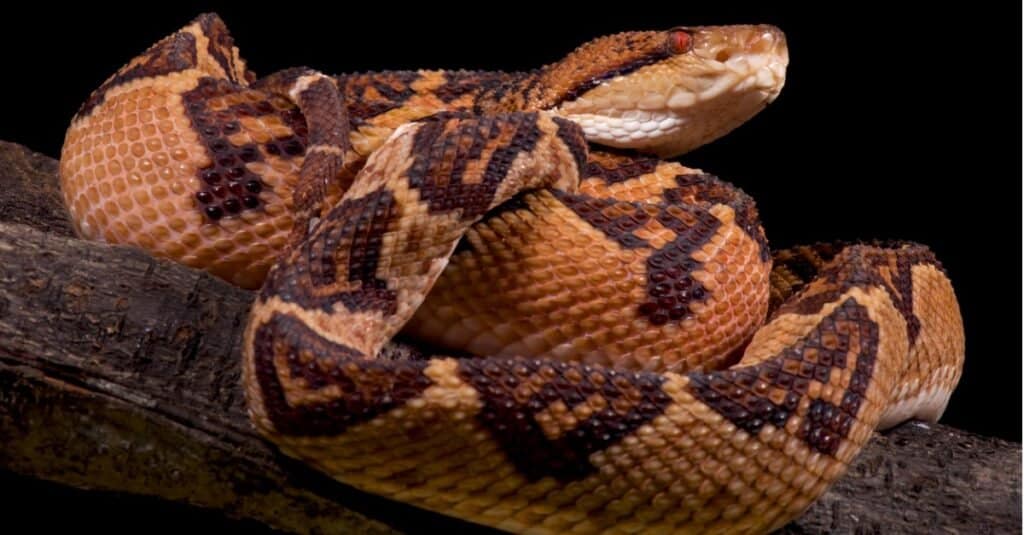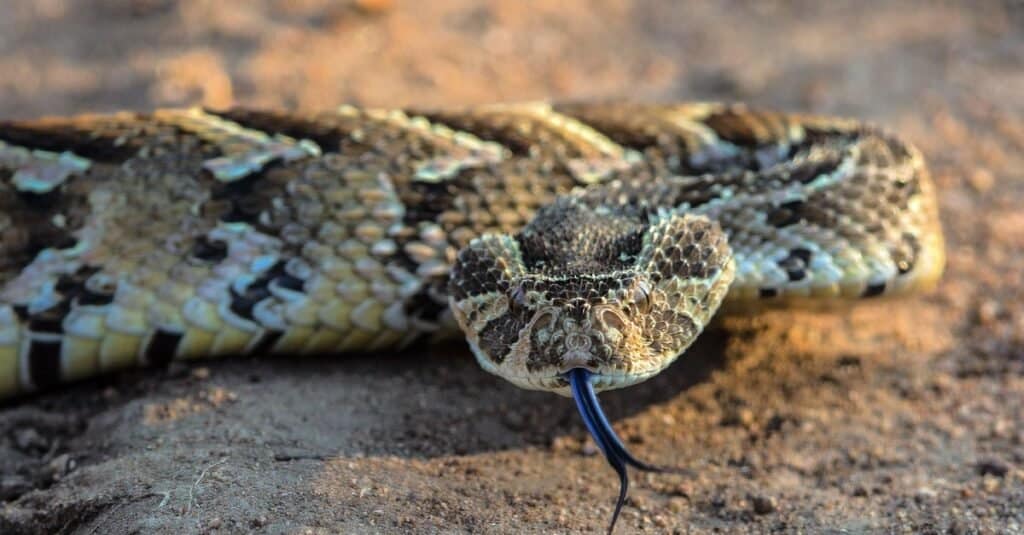There are numerous snake species across the world. Among them are the majestic vipers. These are the most venomous snakes and belong to the Viperidae family. Vipers are everywhere in the world, including the frigid Arctic Circle.
Some vipers can grow to be massive creatures. This article teaches us about the longest viper, which was as long as a surfboard. The South American bushmaster (Lachesis muta) is the largest viper in the world. In fact, the longest bushmaster ever recorded was 11.98 feet long. Discover three reasons why it grew to be so large.

1. Genetics
Snakes, such as the South American bushmaster, can grow to be long and massive!
Essentially, this all boils down to genetics, particularly one gene. Research shows there’s continuous embryonic development that takes place due to an overactive gene. It’s a mutation that makes the trunk of the viper grow longer.
2. Better Body Temperature Control
The South American bushmaster, like all snakes, is a cold-blooded animal. A larger surface area is helpful when the viper needs to warm up or avoid overheating.
For example, if the viper is longer, it can coil and control exposure to the elements. Because exposure affects the body temperature and comfort of the viper, it can expose certain body parts to the sun while keeping the rest cool. Such a snake needs to grow quite long to do this effectively.
3. Increasing Strength
A viper like the South American bushmaster needs to be a formidable predator. In the wild, the snake uses its length and strength as an advantage. Once it gets a hold of the prey, its size overpowers it, making it easier to consume.
Even the shape of a long snake works to its advantage. It can slither and move anywhere in search of prey. Vipers can even move up trees and into rocky areas in search of food.
The Origin of the South American Bushmaster

The South American bushmaster is the largest viper worldwide.
©iStock.com/reptiles4all
The South American bushmaster is a fascinating viper that originates from South America. It’s also found in the Caribbean in Trinidad. It belongs to the family of Viperidae.
Asia pit vipers, lanceheads, and rattlesnakes are in the same family. Adults can vary in length ranging from 6.5 to 8 feet. However, there are longer vipers that are 10 to 11 feet. The South American bushmaster is one of the longest vipers in the world. It beats both the black mamba and the king cobra. Additionally, these vipers can weigh 6.6 to 11 lbs.
Is the South American Bushmaster Viper Venomous?
Yes, the South American bushmaster is a venomous snake. It has impressive and formidable fangs that deliver a lethal dose to prey. However, there have been reports that the viper’s venom may be weaker when compared to others. Still, once this venom hits the bloodstream, it’s game over. After the prey is immobile, the viper proceeds to swallow it whole.
It’s worth noting that the bushmaster is an aggressive snake known to chase after people who bother it.
Are there Other Species of Bushmaster Vipers?
The South American bushmaster is a widely known species. It’s found in South America and parts of the Caribbean. However, this isn’t the only species of the bushmaster viper. Others include the Central American bushmaster, black-headed bushmaster, and Chocoan bushmaster.
The Central American bushmaster shares some similarities with the South American bushmaster. It explains why they were once thought to be the same snake. However, the Central American bushmaster has stripes on the scales behind the eyes. It’s found in rainforests in Costa Rica, Nicaragua, and Panama.
As for the black-headed bushmaster, it’s easy to identify thanks to the black patch on top of its head. It inhabits Central America, specifically Puntarenas in Costa Rica. The longest black-headed bushmaster found was 7.9 feet long.
Next, we have the Chocoan bushmaster. It’s a viper that originates from the Choco department in Colombia. It’s also found in Ecuador and Panama. One distinguishing feature of the Chocoan bushmaster is the scales on its belly that resemble warts.
What are Other Types of Vipers that Grow Quite Long?
The longest viper ever found was a South American bushmaster. It grew to be 11.98 feet long. However, other vipers grow long and massive in the wild, too. These include:
Western Diamondback Rattlesnake
The western diamondback rattlesnake can grow to an impressive 7 feet. In fact, the longest one was 8 feet long. It’s one of the most prominent rattlesnakes in North America and the second longest rattlesnake.
If you want to find the western diamondback, head to the northern parts of Mexico and southwestern parts of the U.S. These are primarily arid and semi-arid areas with little vegetation.
Unlike other rattlesnakes, it’s not easy to tell the age of the western diamondback. It sheds more than once a year, and its rattles break off. Even the fangs of this rattlesnake regrow a few times a year.
Eastern Diamondback Rattlesnake
Next, check out the eastern diamondback rattlesnake. It ranks among the largest vipers in the world and can grow up to 7 feet long. The viper can also weigh upwards of 20 pounds.
Eastern diamondbacks are mostly about 5 feet long, but longer ones aren’t uncommon. In the wild, the viper prefers a diet of birds, smaller reptiles, rodents, and rabbits.
The thick and heavy body of the eastern diamondback is easily noticeable. It has light and dark brown scales and a wide, flat head.
Timber Rattlesnake
Also known as the canebrake rattlesnake, the timber rattlesnake is a pit viper. It’s native to the eastern parts of North America and is a highly venomous viper.
Adult timber rattlesnakes can grow 2 to 5 feet long. However, the longest one known to date was 7 feet long. Its top habitats include parts of Minnesota, New Hampshire, Texas, and Florida.
It primarily feeds on small prey such as frogs, birds, mammals, and even smaller snakes. For example, the timber rattlesnake can eat garter snakes.
Puff Adder
It’s impossible to have a list of the longest vipers without including the puff adder. It’s the longest and the most widely known viper in the world.
The puff adder has been known to grow to be 6 feet long. It has some of the most potent venom and is quite an aggressive viper. It’s better to leave it alone because it won’t hesitate to defend itself by delivering a fatal bite.

The puff adder can grow up to 6 feet long.
©iStock.com/S_Lew
However, puff adders don’t prey on people and prefer eating amphibians like frogs, small mammals, rodents, and birds.
Gaboon Viper
Some vipers may not be the longest, but they are the heaviest. In this category is the gaboon viper, one of the world’s most venomous vipers. It rarely grows past 7 feet long but can weigh over 45 pounds.
The gaboon viper originates from West, East, and Central Africa and prefers living in wet rainforests. It’s a nocturnal animal that prefers to hunt at night under the cover of darkness. Bites from this snake are rare because it almost never ventures out during the day.
Terciopelo
The Terciopelo is a viper from parts of South America, Central America, and Mexico. Such areas have an elevation of up to 2,600 meters.
The longest Terciopelo was 8.2 feet long. It’s a massive snake that can weigh up to 13 lbs.
Terciopelo vipers have broad, flat heads that make them easily distinguishable. Like other snakes, they feed on a wide variety of animals. The Terciopelo diet includes small mammals, amphibians, snakes, rodents, and birds.
If you happen to come across this viper, steer clear. It attacks humans and can move quite fast. Bites can lead to sepsis, which can result in death.
Russell’s Viper
The Russell’s viper originates from the Indian Subcontinent. It’s named after Patrick Russell, a Scottish herpetologist. Russell’s vipers can grow 4 feet long with a 17-inch tail.
Essentially, Russell’s viper is a terrestrial animal that hunts at night. As a nocturnal animal, it prefers the cover of darkness to catch prey. Its primary diet comprises arthropods, land crabs, lizards, and other small animals.
Discover the "Monster" Snake 5X Bigger than an Anaconda
Every day A-Z Animals sends out some of the most incredible facts in the world from our free newsletter. Want to discover the 10 most beautiful snakes in the world, a "snake island" where you're never more than 3 feet from danger, or a "monster" snake 5X larger than an anaconda? Then sign up right now and you'll start receiving our daily newsletter absolutely free.
Thank you for reading! Have some feedback for us? Contact the AZ Animals editorial team.








